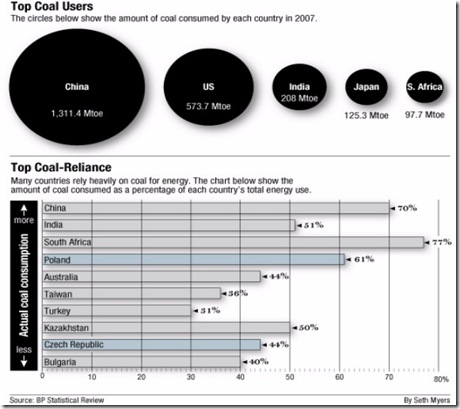Coal Hard Facts
By Robert Bryce -- February 3, 2009It’s easy to bash coal. There’s no romance in the black rocks that provide about half of the electricity in the United States and about 28.6 percent of the world’s total primary energy. And that bashing has become easier still in recent weeks. A few days before Christmas, at a power plant operated by the Tennessee Valley Authority, a huge holding pond failed, spilling coal ash contaminated with a variety of heavy metals including arsenic, lead, barium, chromium and manganese over several hundred acres.[1] On December 29, James Hansen, the high-profile NASA scientist who is closely aligned with former vice president Al Gore on the issue of global warming, sent an open letter to President-elect Barack Obama and his wife, Michelle, in which he called coal-fired power plants “factories of death.”[2]
Add in coal’s other environmental problems—mining by mountain-top removal, air pollution in the form of sulfur dioxide and heavy metals, and heavy loads of particulate—and coal looks pretty bad.
But here’s the problem: some of the world’s biggest economies—and that includes America’s—are heavily dependent on coal. And no other energy source can come close to replacing it, particularly when it comes to cost and scale. A bit of data crunching from the latest BP Statistical Review of World Energy yields a list of the most coal-reliant countries. And that list provides some hints as to why achieving a global carbon emissions reduction plan will be so difficult.
It’s not much of a surprise that South Africa is so coal-reliant. South African giant Sasol produces much of the country’s motor fuel from coal. And China’s heavy reliance on coal is well known. What is somewhat surprising is that of the ten most coal-reliant countries, four are members of the OECD: Australia, Czech Republic, Poland, and Turkey.[3] And of those four, the ones that are most important to Europe and the United States are Poland and the Czech Republic.
Poland and the Czech Republic have a long, bad history with Russia. And Gazprom’s recent curtailment of gas flows to Europe through Ukraine has led to a renewed sense throughout Europe – and Eastern Europe in particular – that any reliance on Russia for energy is simply asking for trouble.
Simply put, it is apparent that for countries like Poland and the Czech Republic, coal is going to retain its majority stake in primary energy production for a long time to come. A few weeks ago, during Ukraine’s long spat with Russia over natural gas prices and supplies, a friend of mine, Konrad Sadurski, a journalist who works for Gazeta Wyborcza, a Warsaw newspaper,[4] emailed me. “Thank God you don’t have cold, cold winters,” he wrote, “and you don’t depend on Russian gas.”
[1] http://www.nytimes.com/2008/12/30/us/30sludge.html?em
[2] http://www.columbia.edu/~jeh1/mailings/
20081229_DearMichelleAndBarack.pdf
[3] http://www.oecd.org/document/58/
0,3343,en_2649_201185_1889402_1_1_1_1,00.html
[4] http://wyborcza.pl/0,82049.html

In addition to your points, Robert, I find it interesting that those who damn coal do so by mixing vintages. Modern coal plants (at least those in the modern developed world) are cleaner and more efficient than the dinosaurs that experience periodic problems. Yet those “so 20th century” plants are always compared to middle-of-this 21st century technology when it comes to renewables.
Thanks for the Guest Post. I am a big fan of Bryce. Always sobering! But I admit that I struggle with the ‘take it or leave’ case that I detect.
Agreed, there is a huge gap between reality of dependency, and desire from many to shift away from coal. But I find myself in the ‘pro coal solutions’ camp- and want to transform emissions from a liability to a profitable resource. How can make use carbon as a profit generating by product? Bio energy.
We cannot sell emissions by thinking like engineers and pumping it underground. That is a cost with no return. To profit we need think as bio-entrepreneurs. Carbon is a feedstock for all growth. Algae and next generation bio solutions are no doubt in the hype stage of growth- but it seems clear that this is our prime candidate for a disruptive, scalable technology solution that could bind carbon to hydrogen instead of oxygen.
While algae derived liquid fuels are grabbing attention, I think a more scalable and realistic solution is using algae to produce electricity using microbial fuel cells that feed existing grid connections for electrons. I’m not convinced that coal plants will want to get into liquid fuel business. But electricity? They are already there.
So– I appreciate the sobering confirmation of how dependent we are on coal, but I think there is a middle ground beyond ‘take it or leave it’ — tap potential of bio energy to turn carbon into a profit-generating resource.
Thanks-
Garry G
Editor
The Energy Roadmap.com
Robert, thanks for this relatively balanced view. Given the environmental problems (other than CO2) associated with coal, it’s hard for anyone who calls himself a libertarian to be happy with the costs that are shifted to others under our current regulatory regime. Nor can one cheer on the obviously negative role that other countries’ governments (and our own foreign policy, which feeds Russia’s) play in spurring the use of this “cheap” resource.
Why aren’t you and others calling for the privatization of the TVA, the deregulation of utilities, immnediate write-offs of capital investments and other steps that would cut the environmental costs of coal?
[…] rbryce placed an observative post today on Coal Hard FactsHere’s a quick excerptIt’s easy to bash coal. There’s no romance in the black rocks that provide about half of the electricity in the United States and about 28.6 percent of the world’s total primary energy. And that bashing has become easier still in recent … […]